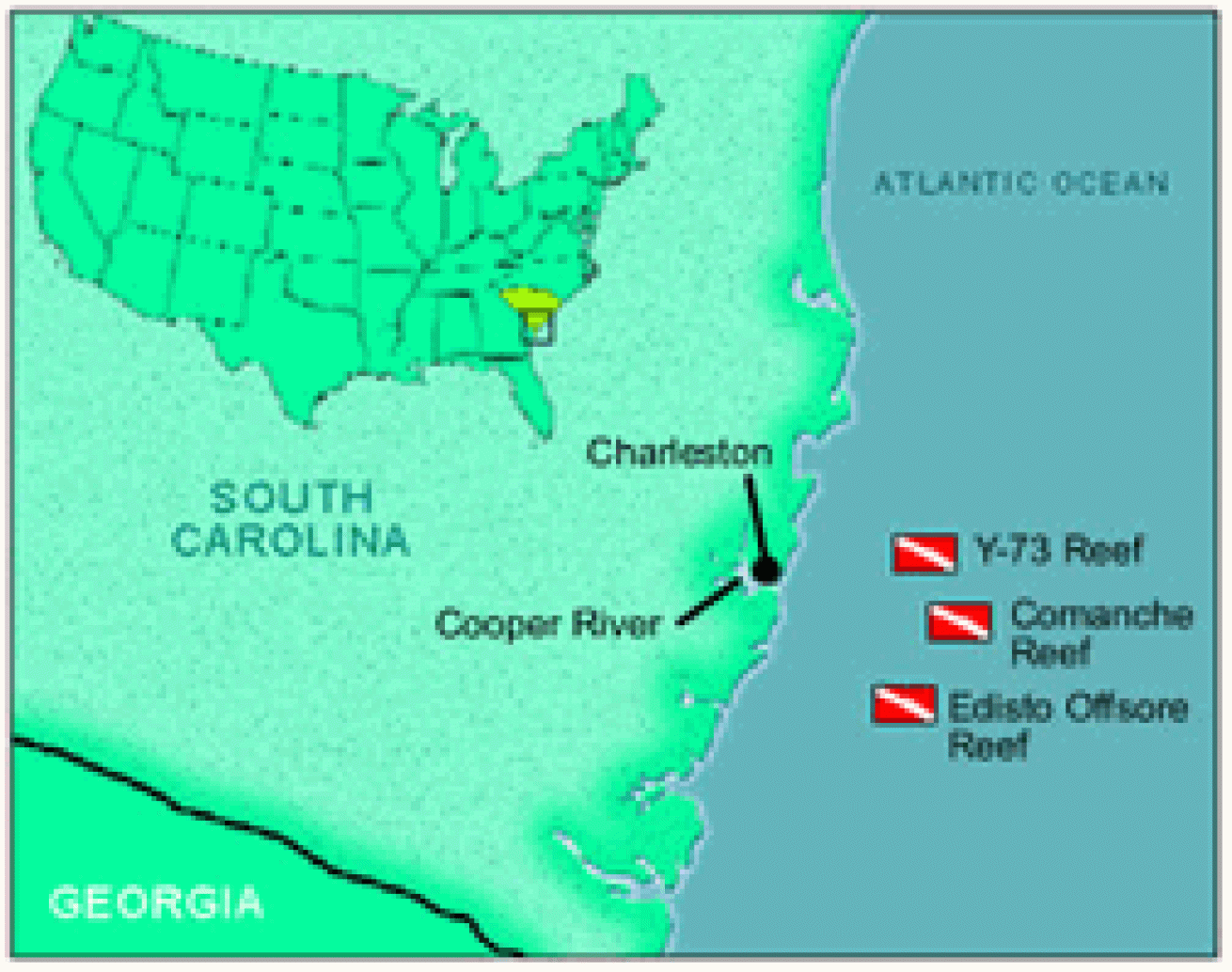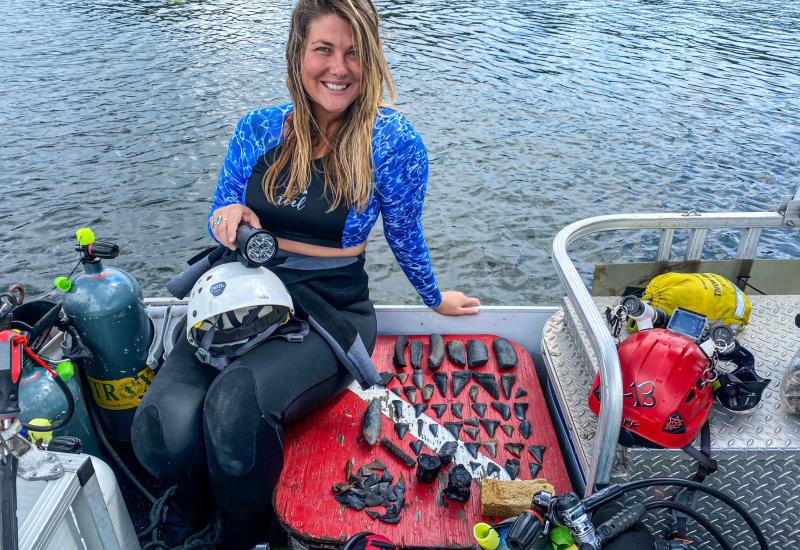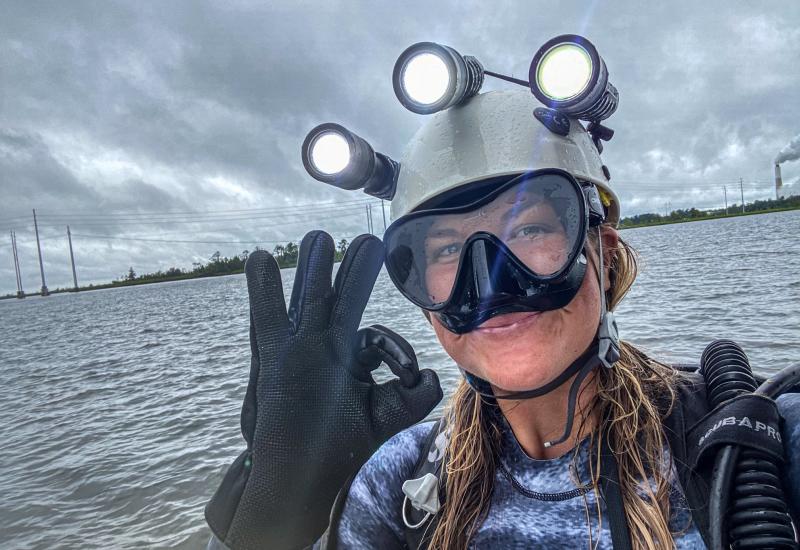South Carolina: Charleston
 |
| Divers scour South Carolina's Cooper River in search of historic artifacts and fossilized shark teeth. |
April 2002
By Sid Wise
||
|---|
|

|
As we followed the anchor line into warm, blue water, we could already discern the dark outline of a ship below. Continuing our descent to the Researcher wreck off Charleston, S.C., a school of curious jacks closed in around us, and at depth, a solid 60 feet of visibility offered a long view fore and aft as filtered sunlight illuminated details of the partially intact wreck resting on her port side.
Here, just a few miles south of murky Charleston harbor, the wreck lies in clear water with her top decks at 60 feet and a maximum depth of 90. Sunk as an artificial reef, Researcher is covered in abundant and colorful sponges and soft corals, and the diversity of colorful fish life from angelfish to snapper seems more indicative of Caribbean reefs than Carolina shores.
The secret is the Gulf Stream. During the dive season from late spring to early fall, clear fish-filled water spins off from the mighty current, infusing wrecks, artificial reefs and natural limestone ridges with Caribbean touches. As a rule of thumb, the farther off shore you go, the better the diving gets.
More than a dozen popular wreck dives offer intrigue for divers of all skill levels. Offshore wrecks like the Comanche, a former Great Lakes icebreaker, are also home to schools of beefy amberjack and spadefish. The Y-73_--a 180-foot tanker submerged in 100 feet of water--houses sharks, rays, grouper and loggerhead turtles. In shallower water, divers will find the freighter _Frederick W. Day, which sank in 1914 with a cargo of cement bags that soon hardened to form the base of a 200-foot-long reef. It's a beginner-friendly site that tops out at 40 feet and hits a max depth of 54 feet.
The Gulf Stream influences don't stop with wrecks. Across the nearly flat bottom at 60 feet, scattered soft corals and sea fans top natural rock outcroppings like those at Indigo Ledges and Anchor Ledges. These outcroppings provide four to six feet of sharp relief from the sand, as well as numerous overhangs where fish big and small go about the business of being fish. Glittering schools of silversides, lobsters peering from small crevices and the presence of three varieties of angelfish--French, queen and gray--add to the Caribbean motif. A small dive light and a head-down position make it easy to search the shallow recesses, where you may even find a nurse shark or two.
Offshore adventures are only half of the Charleston diving story. A few miles inland, advanced divers can scour the dark current of the Cooper River--where the visibility can be measured in inches--in search of historic artifacts and fossilized shark teeth. Farther upstream, where the vis can top out at 10 feet or so, divers with a taste for history can enjoy the Cooper River Underwater Heritage Trail. Developed by the state archaeologists, the marked trail lets divers examine the ruins of historic river ships and plantation-era docks. Blackwater river diving isn't for everyone, but for those whose skills are up to the challenge, the rewards are fascinating.
Dive In: Charleston
Season: Late spring to early fall. Offshore diving is best between May and October.
Water Conditions: Water temperatures peak in the upper 70Fs from June on. Offshore visibility varies widely: from 20 feet to over 80. Expect average visibility of 40 to 60 feet.
Profile: Most wrecks lie at depths of 60 to 90 feet. Ledges are usually found in 45 to 70 feet of water.
River Dives: River dives take place year-round and water temps follow the seasons, from 40F to 45F mid-winter to around 90F in late summer. Cooper River visibility gets as good as 10 feet for shallow archaeological explorations, but is rarely better than a few inches at the bottom. Expect strong currents.
Bonus Tip: Visit the state-of-the-art South Carolina Aquarium while you're in town. For more info: www.scaquarium.org.
Dive Operators: Charleston Scuba, (843) 763-3483; web: www.charlestonscuba.com. Freedom at Depth Diving, (843) 553-8009. Capt. Tom McMillan's A Day on the Cooper River, (843)693-8485; web: www.cooperriver.com.
For More Info: For more information on the Cooper River Underwater Heritage Trail, contact the South Carolina Institute of Archaeology and Anthropology, (843) 762-6105; web: www.cas.sc.edu/sciaa/staff/amerc/CooperRiverTrail.htm. For topside accommodations and diversions, visit the Charleston Area Convention and Visitors Bureau at www.charlestoncvb.com.

Divers scour South Carolina's Cooper River in search of historic artifacts and fossilized shark teeth.
April 2002
By Sid Wise

As we followed the anchor line into warm, blue water, we could already discern the dark outline of a ship below. Continuing our descent to the Researcher wreck off Charleston, S.C., a school of curious jacks closed in around us, and at depth, a solid 60 feet of visibility offered a long view fore and aft as filtered sunlight illuminated details of the partially intact wreck resting on her port side.
Here, just a few miles south of murky Charleston harbor, the wreck lies in clear water with her top decks at 60 feet and a maximum depth of 90. Sunk as an artificial reef, Researcher is covered in abundant and colorful sponges and soft corals, and the diversity of colorful fish life from angelfish to snapper seems more indicative of Caribbean reefs than Carolina shores.
The secret is the Gulf Stream. During the dive season from late spring to early fall, clear fish-filled water spins off from the mighty current, infusing wrecks, artificial reefs and natural limestone ridges with Caribbean touches. As a rule of thumb, the farther off shore you go, the better the diving gets.
More than a dozen popular wreck dives offer intrigue for divers of all skill levels. Offshore wrecks like the Comanche, a former Great Lakes icebreaker, are also home to schools of beefy amberjack and spadefish. The Y-73_--a 180-foot tanker submerged in 100 feet of water--houses sharks, rays, grouper and loggerhead turtles. In shallower water, divers will find the freighter _Frederick W. Day, which sank in 1914 with a cargo of cement bags that soon hardened to form the base of a 200-foot-long reef. It's a beginner-friendly site that tops out at 40 feet and hits a max depth of 54 feet.
The Gulf Stream influences don't stop with wrecks. Across the nearly flat bottom at 60 feet, scattered soft corals and sea fans top natural rock outcroppings like those at Indigo Ledges and Anchor Ledges. These outcroppings provide four to six feet of sharp relief from the sand, as well as numerous overhangs where fish big and small go about the business of being fish. Glittering schools of silversides, lobsters peering from small crevices and the presence of three varieties of angelfish--French, queen and gray--add to the Caribbean motif. A small dive light and a head-down position make it easy to search the shallow recesses, where you may even find a nurse shark or two.
Offshore adventures are only half of the Charleston diving story. A few miles inland, advanced divers can scour the dark current of the Cooper River--where the visibility can be measured in inches--in search of historic artifacts and fossilized shark teeth. Farther upstream, where the vis can top out at 10 feet or so, divers with a taste for history can enjoy the Cooper River Underwater Heritage Trail. Developed by the state archaeologists, the marked trail lets divers examine the ruins of historic river ships and plantation-era docks. Blackwater river diving isn't for everyone, but for those whose skills are up to the challenge, the rewards are fascinating.
Dive In: Charleston
Season: Late spring to early fall. Offshore diving is best between May and October.
Water Conditions: Water temperatures peak in the upper 70Fs from June on. Offshore visibility varies widely: from 20 feet to over 80. Expect average visibility of 40 to 60 feet.
Profile: Most wrecks lie at depths of 60 to 90 feet. Ledges are usually found in 45 to 70 feet of water.
River Dives: River dives take place year-round and water temps follow the seasons, from 40F to 45F mid-winter to around 90F in late summer. Cooper River visibility gets as good as 10 feet for shallow archaeological explorations, but is rarely better than a few inches at the bottom. Expect strong currents.
Bonus Tip: Visit the state-of-the-art South Carolina Aquarium while you're in town. For more info: www.scaquarium.org.
Dive Operators: Charleston Scuba, (843) 763-3483; web: www.charlestonscuba.com. Freedom at Depth Diving, (843) 553-8009. Capt. Tom McMillan's A Day on the Cooper River, (843)693-8485; web: www.cooperriver.com.
For More Info: For more information on the Cooper River Underwater Heritage Trail, contact the South Carolina Institute of Archaeology and Anthropology, (843) 762-6105; web: www.cas.sc.edu/sciaa/staff/amerc/CooperRiverTrail.htm. For topside accommodations and diversions, visit the Charleston Area Convention and Visitors Bureau at www.charlestoncvb.com.










